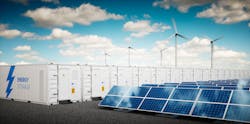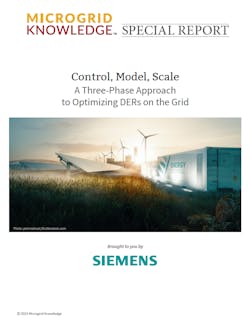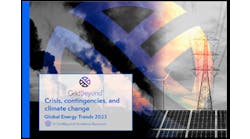In a new special report series, we explore how to optimize DERs on the grid. In this third installment, we explain how to unlock the full potential of DER control and how to scale DER optimization.
DER optimization tools allow a single engineer via a user- friendly interface to change the configuration of a utility’s grid assets without interrupting the system. The key to reaching this desired end state is modeling.
When grid operators say one of their biggest problems is effectively managing the constant changes on the grid brought on by so many DERs, the answer is modeling the DERs on the network.
That’s because DER optimization uses network model- based systems that require model maintenance rather than software maintenance.
Control of and data acquisition from a microgrid is only the first step toward DER optimization. Using data-informed DER control scenarios to create asset configuration models is essential to fully optimize DERs on the system to provide maximum grid flexibility and resilience.
The engineer can model the desired changes first to ensure they won’t cause adverse impacts on the grid, then activate the changes into the production environment using the control system, without taking assets down.
In sum, one engineer can add to and adapt the actual network model without having to reprogram the software.
When grid operators say one of their biggest problems is effectively managing the constant changes on the grid brought on by so many DERs, the solution is modeling the DERs on the network.
Inverter-based DERs can provide reactive power to the grid, which utilities can use to improve power quality, offset the need for new equipment on feeders such as capacitor banks, or increase the lifespan of existing equipment through reduced use.
In effect, the ability to deploy a diverse array of asset configuration models at different times is the missing piece of the grid flexibility puzzle for grid operators struggling to keep up with the rapid rise of DERs on their network.
How to Scale DER Optimization
The journey to DER optimization starts with installing software-based control and data acquisition systems with desired DERs such as utility-owned microgrids. A utility can achieve full optimization of those DERs after it develops asset configuration models and begins to activate them as needed to address various situations on the grid.
However, those portions of the journey do not allow utilities to achieve DER optimization at scale. Scale is the natural next step on the journey, and it is achieved by applying control and data acquisition systems to more DERs and more asset configuration modeling.
Pursuing DER optimization might start with a pilot project testing a single microgrid. Over time, utilities should follow the same process to optimize more and more DERs, particularly as they expand programs that enable control over customer-owned DERs and the ability to request grid support from those assets.
The user interface of software-based control and data acquisition systems allows utilities to add as many assets and as many modeling configurations as they would like. There’s essentially no limit to the software. Utilities can continue to apply the DER optimization approach, scaling the system to hundreds of thousands of assets, if needed.
When the model is small, including only a few assets, the control and data acquisition system could be run from a single server. When the modeling incorporates many DERs across many locations, the system can be run from a central control center. That means, at scale, the same software can allow a utility to grow from optimization of a single utility- owned DER to a system that looks and feels more like a full-scale DER management system (DERMS).
As the software system scales, so, too, does the process the software enables. To scale DER optimization, it is essential to execute asset configuration changes online without taking systems down. It would be impossible to configure changes on thousands of individual asset control systems, but with the software-based DER optimization approach, utilities only need to scale the models within a single system.
Starting small is OK, but lay the groundwork to grow
Utilities can start the DER optimization journey where they are today and invest in scaling up as needed. Most utilities today are starting with the edge device approach.
For example:
- Duke Energy built the Mount Holly microgrid to serve Hot Springs, North Carolina, a remote mountain town that gets power from the electric grid via a 10-mile, 22.86- kV feeder prone to extended outages.
- Eversource recently completed a battery-powered microgrid that meets the needs of 10,000 residents in Provincetown, Massachusetts, and three other outer Cape Cod towns surrounded by water on three sides.
- PG&E launched a remote grid program to take grid- edge communities off the grid. The first project is the Briceburg remote microgrid, located in a fire-prone region outside of Yosemite National Park at the end of a long distribution line. The off-grid, hybrid Briceburg microgrid is expected to be the first of many installed to replace distribution systems in remote areas in PG&E territory.
The one-off, grid-edge approach is a smart way to start for many utilities, but making DER control and data acquisition choices that can scale is critical because the wave of DER adoption is only just beginning.
Wood Mackenzie’s predicted 175 GW of new DER installations in the U.S. by 2026 before the Inflation Reduction Act (IRA) passed into law. The IRA represents the federal government’s largest ever investment into clean energy and includes billions of incentives for conventional DERs, such as solar systems, BESS, and microgrids, as well as for building and vehicle electrification that will result in new loads coming to the grid that can act as DERs for flexible load management.
Michael Jung, executive director of the ICF Climate Center, recommended actions every utility should take to prepare for the IRA-driven wave of DERs in a recent editorial in Utility Dive.
“Utilities can prepare for this scenario by developing a distributed energy resource strategy to integrate DER assets — such as rooftop solar panels, EV chargers, heat pumps and water heaters,” Jung said. “With the right software tools in place, such as DER Management Systems, Advanced Distribution Management Systems or other grid- edge optimization software, DERs can be aggregated and orchestrated to provide various grid services, from system- wide load reduction to localized voltage optimization. This leverages assets at the edge of the distribution system to contribute to the reliability of the overall grid, affording utilities new options to mitigate grid conditions such as peak load and voltage deviation.”
The DER optimization approach enables that vision to the largest scale, but it also allows utilities to start small with a single asset and scale only as needed.
Download the full report “Control, Model, Scale: A Three-Phase Approach to Optimizing DERs on the Grid” courtesy of Siemens to learn more.








